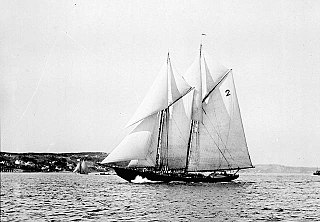
A schooner is a type of sailing vessel defined by its rig: fore-and-aft rigged on all of two or more masts and, in the case of a two-masted schooner, the foremast generally being shorter than the mainmast. A common variant, the topsail schooner also has a square topsail on the foremast, to which may be added a topgallant. Differing definitions leave uncertain whether the addition of a fore course would make such a vessel a brigantine. Many schooners are gaff-rigged, but other examples include Bermuda rig and the staysail schooner.

Lunenburg is a port town on the South Shore of Nova Scotia, Canada. Founded in 1753, the town was one of the first British attempts to settle Protestants in Nova Scotia.

Bluenose was a fishing and racing gaff rig schooner built in 1921 in Lunenburg, Nova Scotia, Canada. A celebrated racing ship and fishing vessel, Bluenose under the command of Angus Walters, became a provincial icon for Nova Scotia and an important Canadian symbol in the 1930s, serving as a working vessel until she was wrecked in 1946. Nicknamed the "Queen of the North Atlantic", she was later commemorated by the Bluenose one-design sloop (1946) and a replica, Bluenose II (1963). The name Bluenose originated as a nickname for Nova Scotians from as early as the late 18th century.

The postal and philatelic history of Canada concerns postage of the territories which have formed Canada. Before Canadian confederation, the colonies of British Columbia and Vancouver Island, Prince Edward Island, Nova Scotia, New Brunswick and Newfoundland issued stamps in their own names. The postal history falls into four major periods: French control (1604–1763), British control (1763–1841), colonial government control (1841–1867), and Canada, since 1867.
Blackjack is a popular casino-gambling card game.

In Canada, a dime is a coin worth ten cents. It has been the physically smallest Canadian coin since 1922; it is smaller even than the penny, despite its higher face value. According to the Royal Canadian Mint, the official national term of the coin is the 10-cent piece, but in practice, the term dime predominates in English-speaking Canada. It is nearly identical in size to the American dime. Unlike its American counterpart, the Canadian dime is magnetic due to a distinct metal composition. From 1968 to 1999, it was composed entirely of nickel, and since 2000, it has consisted of a steel core with plating composed of layers of nickel and copper.
Fish are vertebrates with gills and without digits.
Bullseye or Bull's Eye may refer to:

Riverport is a village in Lunenburg County, Nova Scotia, Canada. The harbour of Ritcey Cove is free from shoals and safe from every wind, considered one of the finest in North America. Riverport is a five-minute drive to several public beaches including Hirtle's Beach, Kingsburg Beach, Oxner Beach, Rose Bay Beach and Spindler Beach.

Bluenose II is a replica of the fishing and racing schooner Bluenose, commissioned by Sidney Culverwell Oland and built in 1963 as a promotional yacht for Oland Brewery. Sidney Oland donated the schooner to Nova Scotia in 1971 and it has since operated as a sailing ambassador and promotional device for Nova Scotia tourism. In honour of her predecessor's record, Bluenose II does not officially race.
William James Roué was a naval architect famous for his design of the fishing schooner Bluenose, which sailed to victory in the Halifax Herald International Fisherman's competition in 1921, 1922, 1923, 1931 and 1938, and held the record for the largest catch of fish ever brought into Lunenburg, Nova Scotia.

The Bluenose is the nickname for a 50-cent definitive postage stamp issued by the Canadian Post Office on 8 January 1929 as part of the King George V "Scroll Issue". Scott number is 158 with a perforation of 12. The stamp depicts the fishing schooner Bluenose and the design, by the Canadian Bank Note Company, Ottawa, is a montage of two different images of the vessel, racing off Halifax Harbour. The stamp is considered a classic even though it was issued after 1900. It has been called "Canada's Finest Stamp" and is a favorite among collectors.
Blue Dolphin was an auxiliary schooner built in 1926 at Shelburne, Nova Scotia by the Shelburne Shipbuilding Company as an adventure yacht. She served as US Navy auxiliary, IX 65 in World War II and as a postwar research vessel made famous by a Stan Rogers song.

Gertrude L. Thebaud was an American fishing and racing schooner built and launched in Essex, Massachusetts in 1930. A celebrated racing competitor of the Canadian Bluenose, it was designed by Frank Paine and built by Arthur D. Story for Louis A. Thebaud, and named for his wife, Gertrude Thebaud. In their first meeting at Gloucester, Massachusetts in October 1930, Gertrude L. Thebaud bested Bluenose 2-0 to win the Sir Thomas Lipton International Fishing Challenge Cup. However, in 1931, two races to none, and again in 1938, three races to two, Bluenose defeated Gertrude L. Thebaud to remain the undefeated holder of the International Fisherman's Trophy. During World War II, the schooner saw service with the United States Coast Guard. The vessel sank in 1948 off the coast of Venezuela.

Angus James Walters was a sailor and sea captain who skippered Bluenose from 1921 to 1938. Walters captained Bluenose to five international sailing races, and was undefeated for seventeen years.

Sherman Zwicker is a wooden auxiliary fishing schooner built in 1942 at the Smith and Rhuland shipyard, Lunenburg, Nova Scotia. Influenced by the design of the famous Bluenose, Sherman Zwicker was built to fish the Grand Banks. The schooner was built for F. Homer Zwicker of Zwicker and Co. Officially christened in 1942, the F/V Sherman Zwicker is the last operable saltbank fishing vessel in existence.
The Columbia was an American schooner, a fishing vessel launched in 1923. She took part in several races, and subsequently disappeared off Nova Scotia in 1927. A replica was built in 2014.










